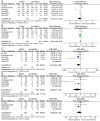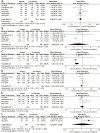Comparing Balloon Dilation to Non-Balloon Dilation for Access in Ultrasound-Guided Percutaneous Nephrolithotomy: A Systematic Review and Meta-Analysis
- PMID: 38166218
- PMCID: PMC10947654
- DOI: 10.1590/S1677-5538.IBJU.2023.0373
Comparing Balloon Dilation to Non-Balloon Dilation for Access in Ultrasound-Guided Percutaneous Nephrolithotomy: A Systematic Review and Meta-Analysis
Abstract
Purpose: This study aims to evaluate the safety and efficacy of ultrasound-guided balloon dilation compared to non-balloon dilation for percutaneous nephrolithotomy (PCNL).
Materials and methods: A systematic review and meta-analysis were conducted by searching PubMed, EMBASE, and the Cochrane Library. Results were filtered using predefined inclusion and exclusion criteria as described and meta-analysis was performed using Review Manager 5.4 software.
Results: A total of six studies involving 1189 patients who underwent PCNL were included. The meta-analysis results demonstrated that compared to non-balloon dilation, balloon dilation was associated with reduced haemoglobin drop [mean difference (MD) = -0.26, 95% CI = -0.40 ~ -0.12, P = 0.0002], decreased transfusion rate [odds ratio (OR) = 0.47, 95% CI = 0.24 ~ 0.92, P = 0.03], shorter tract establishment time (MD = -1.30, 95% CI = -1.87 ~ -0.72, P < 0.0001) and shorter operation time (MD = -5.23, 95% CI = -10.19 ~ -0.27, P = 0.04).
Conclusions: Overall, ultrasound-guided balloon dilatation offered several advantages in PCNL procedures. It facilitated faster access establishment, as evidenced by shorter access creation time. Additionally, it reduced the risk of kidney injury by minimizing postoperative haemoglobin drop and decreasing the need for transfusions. Moreover, it enhanced the efficiency of surgery by reducing the operation time. However, it is important to note that the quality of some included studies was subpar, as they did not adequately control for confounding factors that may affect the outcomes. Therefore, further research is necessary to validate and strengthen these findings.
Keywords: Angioplasty, Balloon; Kidney Calculi; Nephrolithotomy, Percutaneous.
Copyright® by the International Brazilian Journal of Urology.
Conflict of interest statement
None declared.
Figures



Similar articles
-
Comparison of mini percutaneous nephrolithotomy and standard percutaneous nephrolithotomy for renal stones >2cm: a systematic review and meta-analysis.Int Braz J Urol. 2022 Jul-Aug;48(4):637-648. doi: 10.1590/S1677-5538.IBJU.2021.0347. Int Braz J Urol. 2022. PMID: 34786926 Free PMC article.
-
Totally tubeless, tubeless, and tubed percutaneous nephrolithotomy for treating kidney stones.Cochrane Database Syst Rev. 2023 Jul 28;7(7):CD012607. doi: 10.1002/14651858.CD012607.pub2. Cochrane Database Syst Rev. 2023. PMID: 37503906 Free PMC article.
-
One-shot versus gradual dilation technique for tract creation in percutaneous nephrolithotomy: a systematic review and meta-analysis.Urolithiasis. 2013 Oct;41(5):443-8. doi: 10.1007/s00240-013-0583-6. Epub 2013 Jun 18. Urolithiasis. 2013. PMID: 23775113
-
Feasibility, safety, and effectiveness of adult-sized instruments in pediatric percutaneous nephrolithotomy: A systematic review and meta-analysis.J Pediatr Urol. 2022 Jun;18(3):303-310. doi: 10.1016/j.jpurol.2022.04.014. Epub 2022 Apr 22. J Pediatr Urol. 2022. PMID: 35534382
-
Percutaneous nephrolithotomy versus retrograde intrarenal surgery for treatment of renal stones in adults.Cochrane Database Syst Rev. 2023 Nov 13;11(11):CD013445. doi: 10.1002/14651858.CD013445.pub2. Cochrane Database Syst Rev. 2023. PMID: 37955353 Free PMC article.
Cited by
-
Comparison of two different tract dilatation techniques in percutaneous nephrolithotomy: Amplatz versus balloon.Urolithiasis. 2025 Jun 21;53(1):123. doi: 10.1007/s00240-025-01800-6. Urolithiasis. 2025. PMID: 40542823
-
Infertility is the hot topic in the 1st number of International Brazilian Journal of Urology in 2024.Int Braz J Urol. 2024 Jan-Feb;50(1):1-3. doi: 10.1590/S1677-5538.IBJU.2024.01.01. Int Braz J Urol. 2024. PMID: 38166215 Free PMC article. No abstract available.
-
A comparison on safety and efficacy between 24 Fr versus 18 Fr pneumatic balloon dilators for percutaneous treatment of renal stones between 10 and 20 mm: results from a contemporary cohort.World J Urol. 2025 Jan 20;43(1):79. doi: 10.1007/s00345-025-05445-3. World J Urol. 2025. PMID: 39831909 Clinical Trial.
-
Clinical analysis of ultrasound-guided "tract without bleeding vessel requiring embolization (TBVE)" in reducing bleeding during percutaneous nephrolithotomy.BMC Urol. 2025 Aug 7;25(1):192. doi: 10.1186/s12894-025-01891-8. BMC Urol. 2025. PMID: 40775332 Free PMC article.
-
Therapeutic experience and key techniques of tubeless percutaneous nephrolithotomy.Sci Rep. 2025 Jan 7;15(1):1106. doi: 10.1038/s41598-024-84806-1. Sci Rep. 2025. PMID: 39774776 Free PMC article.
References
-
- Preminger GM, Assimos DG, Lingeman JE, Nakada SY, Pearle MS, Wolf JS., Jr AUA Nephrolithiasis Guideline Panel). Chapter 1: AUA guideline on management of staghorn calculi: diagnosis and treatment recommendations. J Urol. 2005;173:1991–2000. - PubMed
-
- Gönen M, Istanbulluoglu OM, Cicek T, Ozturk B, Ozkardes H. Balloon dilatation versus Amplatz dilatation for nephrostomy tract dilatation. J Endourol. 2008;22:901–904. - PubMed
-
- Ozok HU, Sagnak L, Senturk AB, Karakoyunlu N, Topaloglu H, Ersoy H. A comparison of metal telescopic dilators and Amplatz dilators for nephrostomy tract dilation in percutaneous nephrolithotomy. J Endourol. 2012;26:630–634. - PubMed
-
- Dehong C, Liangren L, Huawei L, Qiang W. A comparison among four tract dilation methods of percutaneous nephrolithotomy: a systematic review and meta-analysis. Urolithiasis. 2013;41:523–530. - PubMed
-
- Fernström I, Johansson B. Percutaneous pyelolithotomy. A new extraction technique. Scand J Urol Nephrol. 1976;10:257–259. - PubMed
Publication types
MeSH terms
Substances
LinkOut - more resources
Full Text Sources
